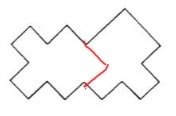-
Posts
2578 -
Joined
-
Days Won
21
Content Type
Profiles
Forums
Events
Posts posted by Ghideon
-
-
Spoiler18 minutes ago, Genady said:
This rail with teeth runs in the middle, but there are two normal rails outside. The wheels on these rails are normal railroad wheels with guides, I think.
Today yes, initially not necessarily so (if the source above is correct)
"The system was also capable of guiding the car without the need for flanges on the wheels. Indeed, the first cars on Pilatus had no flanges on running wheels, but they were later added to allow cars to be moved through tracks without rack rails during maintenance." https://en.wikipedia.org/wiki/Pilatus_Railway
0 -
Spoiler7 hours ago, Genady said:
I don't know about railroad trains without guides on the wheels. What stops them from sliding off the rails?
SpoilerFor instance the Locher rack system, also used to propel the train. Used on trains on rack railways

Found a reference: https://en.wikipedia.org/wiki/Pilatus_Railway
0 -
39 minutes ago, Genady said:
There is a group of four prisoners, Al, Bill, Chuck, and Dick. After one year in prison, they have a chance to be released. It works as follows.
There is a room with a row of four boxes. Slips with the prisoners' names are randomly placed in the boxes, one per box.
Each prisoner enters the room, one at a time, checks one or two boxes of their choice, leaves the room without changing anything, and goes to his cell without any communication with other prisoners. Next prisoner enters the room. Etc.
If each prisoner finds his names in the boxes he checks, all four are released. If even one of them does not find his name, all four stay in prison for another year. A year later, they get this chance again. Of course, the slips are placed randomly again then.
How long are they expected to stay in prison? The calculation is straightforward. Each prisoner has 1/2 chance to find his name by checking two out of the four boxes. A chance that all four will find their names is 1/2 x 1/2 x 1/2 x 1/2 = 1/16. Thus, they are statistically expected to stay in prison for 16 years.
It turned out that there is a strategy which shortens this time. Significantly. Down to 2-3 years!
What is the strategy?
No tricks. Pure strategy.
They can strategize only before entering the room.
.
SpoilerIdea: If they choose at random there are combinations where the same two boxes are opened by all four prisoners. They should decide something like numbering system from left to right so that Al checks box 1,2, Chuck 3,4, Bill 1,3 Dick 2,4 to reduce the number of times they check combinations that can't possibly be correct.
0 -
On 5/22/2023 at 7:31 PM, Genady said:
When a train moves forward there is always a part of it that moves backward relative to the ground. What part is it?
.
SpoilerFrom the correct answer above I have two possible alternatives. (Correct or not may be depend on translation and definition
 )
)
1: The rear facing seats (an anyone seated in them) on the train will always move backwards relative to the ground (but not relative to the train).
2: Electricity from the current collector, supplying anything behind the current collector, will move backwards relative to the ground (and relative train)Note: All trains aren't electrical. All trains don't have rear facing seats. Also, as far as I know there are/were trains without flanges on running wheels.
1 -
11 hours ago, Genady said:
A car goes 15 mph for 1 mile. How fast must it go in the same 1 mile back to average 30 mph for the entire round trip?
Trying an alternative just for fun:
SpoilerAssume it's kind of a trick question; The problem has, from an engineering perspective, low precision meaning that there are rounding errors to account for. 30 could mean 30+-0.5? Allowing the average speed to be as low as 29.5 means the return trip speed is at least 880mph (two digit precision). Given that the current land speed record according to wikipedia is 760.343mph we can safely assume that the it is not possible for a car to drive at that speed at this time.
 1
1 -
On 5/18/2023 at 5:29 PM, Genady said:Spoiler
3? Cut each link in one of the segments resulting in three open links an three segments. Use the three open links to join the three segments into a loop.
1 -
This cut?
Spoiler 1
1 -
37 minutes ago, Baron d'Holbach said:
I published Pime mechanics, March 14 2023, you know saying over the top stuff, gravity created everything, light ech..... 3 weeks later, "physicist discover that gravity created light."
...and I'm like, ..... seriously... what the heck, where's my noble prize. So, now I'm like okay, Prime Mechanics has showcase a appetizer. Let's see 👀
Earliest reports is first week of April. I haven't seen any reports earlier on Google.
Google returns references to the paper "Graviton to Photon Conversion via Parametric Resonance" by Robert Brandenberger, Paola C. M. Delgado, Alexander Ganz, Chunshan Lin, first version submitted to arXiv on 18 May 2022.
0 -
55 minutes ago, Genady said:
It doesn't go through the entire NN every time, but rather a random subset. So, it produces different response every time you run it. I got a similar, correct answer on the 6th trial.
Thanks! I did not think of repeating the query.
0 -
On 5/2/2023 at 2:45 AM, Genady said:
What??
Interesting, I wonder what causes differences. I just tried:
QuoteMe: Joan is Katy's daughter. Who is younger?
ChatGPT:
Katy's daughter, Joan, is younger than Katy.
(ChatGPT 4, Mar 23 Version)
0 -
16 hours ago, studiot said:
I'm glad the members are less polarised and more objective than your fears.
I think it's too early to assess the depth of polarisation.
Thanks for your reply!
I think I need to clarify; I'm speaking about a polarised debate on global level. Discussion here on the forum is quite objective. I'll continue to follow this topic. A basic example: some jurisdictions have rules about giving financial product advice. How will such rules be modified when tools such as ChatGPT are available and in use in regulated areas? I do not know but I'm curios. (I'm currently on an assignment in the financial industry)
I had not seen the Hofstadter text before, I'll look more into what he as to say.
0 -
On 4/2/2023 at 12:52 PM, studiot said:
I am also suprised or curious why so few members are interested in this topic
I just wanted to say that I find this topic to be one of the most interesting discussions lately, and I'm closely following the debate. However, I'm having trouble formulating a substantial contribution. One observation I'd like to make is that generative AI seems to have ignited an increasingly polarized debate between its proponents and opponents, potentially more so than many previous applications of computer science. Do you share my observation, or do you have a different perspective?
0 -
12 hours ago, Photon Guy said:
An email address is much easier to remember since I've got only one.
I prefer a different approach; having one separate email adress per online registration*. I prefer similar (or identical) user name for different sites and the ability to drop an email adress if it is misused. I notice that some sites allow for the user to enter username or email adress, maybe such an option will be available in this forum.
Example screen shot from a random internet service:

*) there are automated services for this to reduce any overhead or administration
0 -
2 hours ago, Abouzar Bahari said:
my paper has been verified already by very famous scientists like Prof. Hal Puthoff.
Hello, I'm unable to find* a prof. Hal Puthoff using search engines, can you provide some reference to relevant work for this topic?
*) I found other titels and similar names but no professor.
0 -
On 2/16/2023 at 8:54 PM, studiot said:
really don't know the answer to this but I was thinking that you need to distinguish between a 'do nothing' instruction and a halt instruction which is not the same thing.
I would interpret a do nothing instruction as equivalent to the zero function in your terms, which surely would make it the same as Ghideon's wait instruction.
Thanks for the reply. I think your 'halt' is an excellent way to show what I think of but I lack the mathematic knowledge to express, +1. My reasoning: The outcome when step-by-step instructions is running in a CPU could as far as I know be expressed mathematically using boolean algebra and circuit logics. This includes the 'Null' or 'NOP'* instruction. But an instruction that requires an external interrupt does not necessary have any upper limit for how long it takes for the interrupt to occur. When the time is unbounded a "step" seems different from a mathematical perspective. I think my question is related to this statement:
On 2/17/2023 at 1:29 AM, wtf said:They make a succession of transitions from one state to another, and those transitions can be taken to be mathematical functions.
I'm curious what kind of mathematical functions are required and if/how that depends on the types of instructions and level of abstraction (CPU, Machine code, higher level) and if these functions are what OP described.
*) No operation
1 -
13 minutes ago, Willem F Esterhuyse said:
When something cools down it gets colder, hence it's coldness increased, so can't you say that coldness flowed into the warmness?
Since this is speculations, what is your reasoning and arguments for making this claim?
(The answer according to established models is "No, it is not correct to say that coldness flows into warmness when something cools down. ")
0 -
5 hours ago, ALine said:A step in programming is a function in mathematics.Proof:A function is a relationship between two sets.A set can be represented as being a list or tuple of programs.A function is just a transition between programs.Therefore a step is a function.
I'm not sure I follow the idea, maybe you can you define "step"?
On a low level (interactions for a CPU) @studiot's halt* example could mean that the CPU will wait for an external interrupt. Are these signals part of your steps?
*) I use HLT (x86) here
0 -
36 minutes ago, Genady said:
If the numbering is not technically possible, then maybe there are alternatives available? E.g., an easy way to link to a post.
There is a function available by clicking "more options" for a post (may be different between devices and browsers) :
This windows appear and the direct link is presented:

Here is the result when using your post above:
edit: x-post with @iNow
1 -
1 hour ago, Tom Booth said:
The Caloric theory predated Carnot, but I'm mainly referring to Carnot's likening heat powering a heat engine to water going over a mill wheel. As far as I'm aware that was Carnot's original conception.
The opening question was "According to mainstream physics: Is heat "destroyed" in a heat engine?". Do you want the answer as stated by current mainstream physics of today? Or do you want the answer as it was in mainstream physics at some specific time in the past? (Or other alternative?). Since many historical references are brought up, can you clarify?
2 -
5 hours ago, Tom Booth said:
The question is:
According to mainstream physics: Is heat "destroyed" in a heat engine?
That question have ben answered several times already. Note that some of the input heat energy being converted into useful work output. This is the basic principle behind the operation of a heat engine.
1 -
11 minutes ago, Tom Booth said:
If there is a simultaneous addition of heat. i.e. Isothermal expansion for example; the working fluid which would otherwise suffer a drop in temperature maintains the temperature due to additional simultaneous heat input alongside the work output. It may even increase in temperature, none of that however negates or contradicts the principle involved as far as heat being converted into work.
For every unit of work output a unit of the heat/energy input to the engine "disappears" or is subtracted from the account so to speak.
(bold by me)
By "account" you mean the total energy input?
(Don't forget about the heat that is rejected from a heat engine.)
0 -
43 minutes ago, Tom Booth said:
A bit repetitions but clear enough.
Work performed by the "working fluid" (air or gas) in a heat engine results in a temperature drop of the working fluid.
Work goes out, the temperature goes down. Period. A basic principle, widely accepted.
Perhaps the drop in temperature can sometimes be compensated for but that does not negate the principle: conversion of heat into work results in a temperature drop within the working fluid as a consequence of the energy output.
True or not?
What does the bold part mean?
(Bold highlight by me)
0 -
20 minutes ago, Tom Booth said:
If you don't mind, please quote the specific statement, words of mine, sentence, paragraph or whatever to which you are referring by the bolded words.
Advice: Maybe you can ask about what established science agrees upon to be correct instead? That may allow for the discussion to progress.
0 -
3 hours ago, Tom Booth said:
In this case, the term "disappears" is used.
The idea that heat "disappears" during the performance of work in a heat engine seems to be a reasonable a way of expressing the fact that heat energy is converted into other forms of energy, such as mechanical work or kinetic energy, and is no longer available as heat. Note that text was written 1921 and science, and associated descriptions, may have moved on since then.
4 hours ago, Tom Booth said:Could you be more specific?
What is meant by "converted to another form" exactly?
The terminology used to describe the conversion of heat energy into other forms of energy can vary depending on the context and level of detail of the discussion. For example, in some contexts, it may be more appropriate to say that the heat energy is "transferred" or "converted" rather than "disappears", since the energy is still present but has changed form. Similarly, the specific mechanisms by which heat energy is converted into work or other forms of energy may be described in different ways depending on the level of detail and the theoretical framework being used. For instance:
Level of detail: At a general level, the focus may be on the overall efficiency or performance of a heat engine or energy system, without necessarily specifying the exact mechanisms of energy transfer or conversion.
Context: For example, in the context of engineering or applications, the terminology may be more technical and focused on the practical aspects of energy conversion and efficiency. In the context of a more theoretical or scientific discussion, the terminology may be more abstract.
Theoretical framework: The specific theoretical framework being used to describe thermodynamic phenomena can also have an impact on the terminology used.
Note that for more understanding and for adding ability to predict behaviour you may use models and mathematics in addition to written descriptions. Hope this helps guiding you toward the more specific answer you requested.
0




Hijack from Speed of Time
in Speculations
Posted
No private meetings needed. The robustness of scientific methods enables independent researchers to reach the same conclusions.